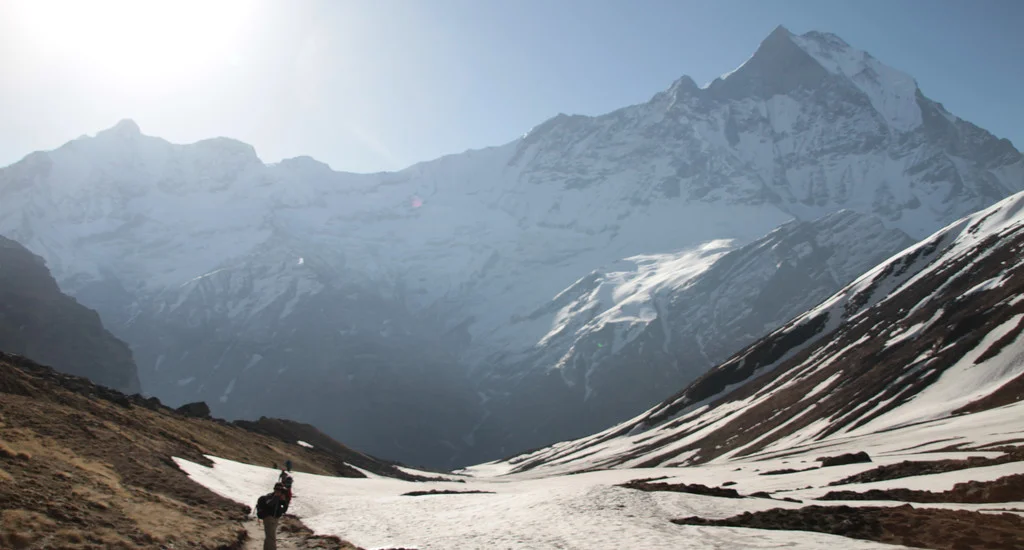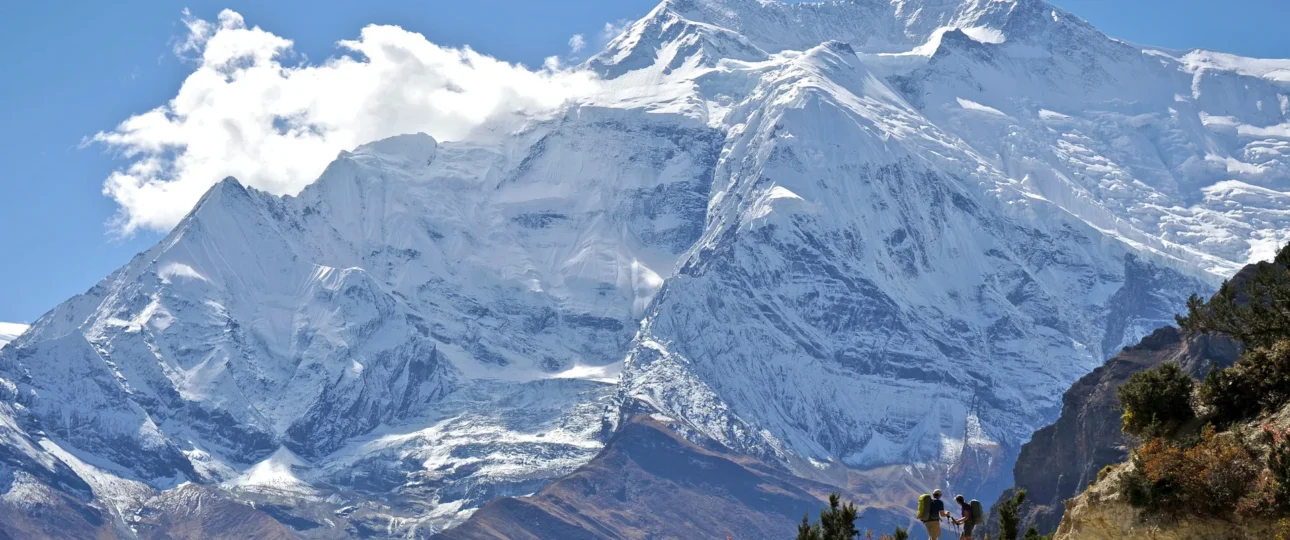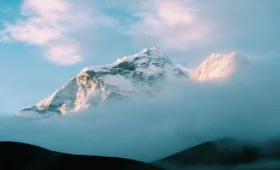The Annapurna Himalaya in Nepal, is part of the great Himalayas. It’s known for its adventurous appeal. There lies Annapurna One, world’s 10th highest peak. It’s a sight to behold. But its peak has inherent risks. Annapurna Himalaya however isn’t just for daring climbers. The famous Annapurna Circuit trek here offers different delights. Trekkers experience unique cultural moments and stunning scenery. It’s a journey that leaves you feeling accomplished.
Table of Contents
Annapurna One: The Heart of the Annapurna Himalayas
Annapurna One, at a high 8,091 meters (26,545 ft), is a massive part of the Annapurna Himalayas. It’s a mountain filled with stories of goals and danger, attracting brave climbers to its risky paths. The first to reach the peak were French climbers Maurice Herzog and Louis Lachenal in 1950, changing climbing history forever.
That said, Annapurna One is known to be one of the world’s most lethal peaks. It offers massive difficulties: extreme weather, scary ice, and the constant threat of snow slides. To climb Annapurna One, you need outstanding climbing skills, careful plans, and lots of experience.
Annapurna Circuit: A Himalayan Trekking Classic
The Annapurna Circuit trek is globally renowned for its extraordinary blend of natural beauty, cultural immersion, and physical challenge. This iconic route circles the Annapurna massif, taking trekkers through a panorama of Himalayan landscapes. Expect lush valleys, quaint villages, cascading waterfalls, towering snow-capped peaks, and the dramatic Thorong La Pass (5,416 meters/17,769 ft). Depending on your itinerary, the trek typically takes between 12 and 21 days to complete.
The Annapurna Circuit’s enduring popularity stems from several factors:
- Accessibility: While demanding, the trek welcomes trekkers with a good fitness level, making it a gateway to the Himalayas even for those without prior mountaineering experience.
- Diversity: From subtropical forests to high-altitude deserts, the constantly changing scenery keeps the trek visually captivating.
- Cultural Encounters: Interacting with local communities along the trail offers a window into the fascinating cultures that call the Annapurna region home.

Best Time of Year for Trekking the Annapurna Circuit
The best time to trek the Annapurna Circuit is during the following seasons:
- Spring (March-May): Pleasant temperatures, blooming rhododendrons, and clear skies (potential for snow at higher passes).
- Autumn (October-November): Stable weather, crisp views, and vibrant fall colours.
Trekking in monsoon season (June-September) is possible, but expect heavy rainfall and potential trail disruptions. While winter offers solitude, the cold and increased snow cover makes it a much more challenging undertaking.
Here’s a breakdown of the planning aspects of the Annapurna Circuit:
Planning Your Annapurna Circuit Adventure
Embarking on the Annapurna Circuit requires careful planning to ensure a smooth and rewarding experience. Here’s what you need to consider:
- Visas, Permits, and Logistics:
- Visa: Citizens of most countries can obtain a visa on arrival in Nepal.
Permits: You’ll need an Annapurna Conservation Area Project (ACAP) permit and a Trekkers’ Information Management Systems (TIMS) card.
- Packing Essentials: Your packing list will vary based on the season, but essentials include:
- Sturdy hiking boots
- Layered clothing for changing temperatures
- Waterproof jacket and pants
- Warm hat, gloves, and thermal layers
- Sleeping bag (teahouses provide blankets, but an extra layer adds warmth)
- Water bottle and purification tabs
- Trekking poles
- First-aid kit and personal medications
Top Experiences on the Annapurna Circuit
The Annapurna Circuit is packed with unforgettable highlights. Here’s a taste of what’s in store:
- Picturesque Villages: Immerse yourself in traditional Nepali life in villages like Manang and Pisang.
- Stunning Viewpoints: Enjoy panoramic vistas from Poon Hill or the breathtaking sunrise over Annapurna from Tadapani.
- Thorong La Pass: Cross the iconic Thorong La Pass, the highest point on the trek, with its rewarding views.
- Muktinath Temple: Visit this sacred pilgrimage site for both Hindus and Buddhists.
Possible Side Treks: Add a detour off the main Circuit to explore the Annapurna Base Camp or Tilicho Lake.

Beyond the Annapurna Circuit: More in the Annapurna Region
While the Annapurna Circuit takes centre stage, the region offers a wealth of diverse trekking adventures for all levels:
· Annapurna Base Camp Trek: Standing directly within the embrace of the Annapurna giants, Annapurna Base Camp (ABC) offers a shorter but equally stunning alternative to the Circuit. This trek takes you into the heart of the Annapurna Sanctuary, surrounded by awe-inspiring peaks.
· Mardi Himal Trek: This gem unveils spectacular mountain views with fewer crowds compared to the popular ABC trek. Follow forested ridges to the Mardi Himal Base Camp, offering incredible up-close vistas of Machhapuchhre (Fishtail Mountain).
· Poon Hill Trek (Ghorepani): A perfect short trek for those with limited time, the Poon Hill trek rewards with unforgettable Himalayan panoramas. The sunrise view from Poon Hill is legendary for a reason!
· Khopra Ridge Trek: Escape the well-trodden paths on the Khopra Ridge trek. Enjoy a less-crowded experience with views of Annapurna and Dhaulagiri, along with the chance to immerse yourself in traditional Gurung villages.
· Nar Phu Valley Trek: Venturing into the restricted region of Nar and Phu offers cultural and landscape wonders. This remote trek combines Tibetan-influenced villages, ancient monasteries, and stark high-altitude scenery.
Important Note: Smaller treks often connect with the main Annapurna Circuit route, offering flexibility for creating your perfect adventure.

Frequently Asked Questions about the Annapurna Himalaya
Is the Annapurna Circuit Trek right for me?
The Annapurna Circuit is a good fit if you have a reasonable fitness level and a sense of adventure and are willing to embrace the challenges of high-altitude trekking in basic teahouse accommodations.
How much does it cost to trek the Annapurna Circuit?
Depends on individual package .Please refer to our Annapurna region page for more info
Is it safe to trek in the Annapurna Himalayas?
Trekking in the Annapurna is generally safe, but being aware of risks like altitude sickness is essential. Take precautions: acclimatize properly, stay hydrated, and listen to your body. Choosing a reputable guide company (if trekking guided) enhances safety.
Can a solo female trekker can go Annapurna?
Yes , We will provide you a female guide if that what client request
Do I need a guide for the Annapurna Circuit?
A guide is beneficial, especially for first-time trekkers. They handle logistics, navigation, and cultural interactions and can enhance safety by spotting potential issues like altitude sickness
What’s the food like on the Annapurna Circuit?
Teahouses serve simple but hearty meals – expect plenty of dal bhat (lentils and rice), noodles, soups, and basic Western options. Bring snacks for trail energy.
How do I avoid altitude sickness?
Ascend gradually, drink plenty of water, listen to your body, and have rest/acclimatization days built into your itinerary
Is travel insurance necessary?
Absolutely! Travel insurance covering high-altitude trekking and potential emergency evacuations is non-negotiable.
When can I find the least crowds on the trail?
Trekking just before or after peak season (late February, early March, or December) offers a quieter experience. Please contact us for more detail information
The Annapurna Himalaya, with its blend of challenging peaks, diverse trails, and welcoming cultures, offers unforgettable experiences. Whether you dream of conquering Annapurna One, exploring the Annapurna Circuit, or venturing into its hidden corners, this region promises the adventure of a lifetime. With good preparation and a spirit of discovery, the Annapurna Himalaya awaits!



